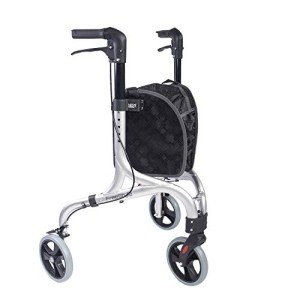medical-walker9868
medical-walker9868
See What Rollator For Walking Tricks The Celebs Are Using
Understanding Rollators for Walking: A Comprehensive Guide
Rollators are a vital mobility aid that improves the freedom and self-reliance of those with restricted walking capabilities. They are developed not just to use stability and assistance but also to encourage mobility and engagement in daily activities for people of all ages. This post digs deep into the world of rollators, supplying insights into their features, benefits, types, upkeep, and essential factors to consider when selecting the most appropriate design.
What is a Rollator?
A rollator is a mobile walking aid equipped with 4 wheels, handgrips, a seat, and frequently includes extra features such as storage baskets and brakes. Unlike traditional walkers, which require the user to lift them off the ground, rollators can be pressed along as the user strolls, making them especially useful for individuals with limited strength or balance.
Secret Features of Rollators
Rollators consist of several functions that enhance their functionality:
- Wheels: Most rollators come with swivel or fixed wheels for better maneuverability indoors and outdoors.
- Brakes: Hand brakes enable users to manage their speed and stop securely.
- Seat: Many rollators offer a built-in seat for users to rest when required.
- Lightweight Frame: Constructed from lightweight products, rollators are easy to raise and transport.
- Adjustable Height: Most rollators allow for height adjustments to accommodate the user’s stature.
Benefits of Using a Rollator
Utilizing a rollator offers numerous advantages, especially for seniors and individuals with mobility difficulties. These may include:
- Improved Stability: Rollators provide a stable base that helps avoid falls.
- Increased Mobility: Users can move about more easily, whether indoors or outdoors.
- Improved Independence: With a rollator, users can carry out day-to-day jobs without needing assistance.
- Practical Seating: The accessibility of a seat allows users to rest whenever they feel fatigued.
Kinds of Rollators
When thinking about which Rollator For Walking to choose, it’s important to acknowledge the different types offered. The main categories include:

- Standard Rollators: Typically have 4 wheels and a seat, appropriate for the majority of indoor and outdoor environments.
- Heavy-Duty Rollators: Designed for bigger people, these rollators have strengthened frames and greater weight capacities.
- Three-Wheel Rollators: These supply a more lightweight and compact alternative, making them perfect for narrower spaces.
- Foldable Rollators: Convenient for transport, these models can be quickly collapsed and stored when not in use.
| Type of Rollator | Description | Best For |
|---|---|---|
| Standard Rollator | 4 wheels, seat, lots of options. | General use, indoor and outdoor. |
| Sturdy Rollator | Reinforced for higher weight capacity. | Bigger individuals requiring additional support. |
| Three-Wheel Rollator | Compact and lightweight, easy to maneuver. | Minimal space and indoor use. |
| Foldable Rollator | Collapsible for simple transportation. | Regular tourists or caretakers. |
How to Choose the Right Rollator
Selecting the ideal rollator includes thinking about a number of aspects to meet the individual’s specific requirements:
- Weight Capacity: Ensure the rollator can support the user’s weight.
- Height Adjustability: Look for designs that can be gotten used to the user’s height for optimal convenience.
- Features Needed: Consider whether extra functions like baskets, trays, or hand brakes are very important.
- Meant Use: Determine if the rollator will be mainly used inside, outdoors, or both.
Maintenance Tips for Rollators
To lengthen the life-span and performance of a rollator, routine maintenance is vital. Here are some beneficial ideas:
- Check Brakes: Regularly test brakes to guarantee they engage correctly.
- Examine Wheels: Look for signs of wear and tear; wheels ought to roll efficiently.
- Tidy Regularly: Wipe down the frame and elements to prevent dirt buildup.
- Tighten Bolts: Periodically check and tighten up any loose bolts or screws.
Often Asked Questions (FAQs)
1. Can rollators be used on irregular surfaces?
Yes, many rollators are created with bigger wheels or specialized treads to handle irregular surface areas. However, users ought to work out caution and guarantee they feel stable when navigating such terrains.
2. How do I measure the proper height for a rollator?
When standing directly, the handles of the rollator should line up with the user’s wrist when their arms are unwinded at their sides. This position ensures comfy use.
3. Do I need a prescription to buy a rollator?
No, rollators can be purchased without a prescription. However, speaking with a health care expert can be helpful to identify the best alternative based upon individual needs.
4. Are rollators covered by insurance coverage?
Protection for rollators can differ based upon the type of insurance strategy. Lots of Medicare strategies provide coverage for some types of walkers, including rollators. It’s advisable to talk to the insurance coverage service provider straight.
Rollators for walking considerably enhance the lives of numerous individuals facing mobility obstacles. Providing stability, independence, and ease of motion, they serve as important tools for maintaining an active way of life. Comprehending the different types, functions, and how to keep them in good condition can empower users in making informed decisions. As mobility requirements differ considerably from individual to person, it is important to pick a rollator that best satisfies private requirements and boosts lifestyle.


